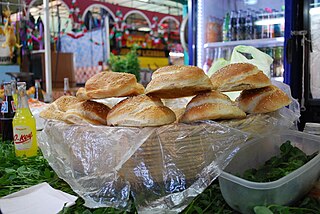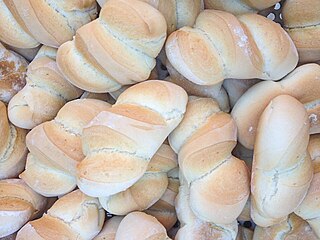
A fried egg, also known as " sunny-side up " is a cooked dish made from one or more eggs which are removed from their shells and placed into a frying pan and fried. They are traditionally eaten for breakfast in many countries but may also be served at other times of the day.

Wonder Bread is a brand of sliced bread which originated in the United States in 1921 and was one of the first to be sold pre-sliced nationwide in 1930. The brand is currently owned by Flowers Foods in the United States.

The milanesa is a South American variation of the Lombard Veal Milanese, or the Austrian Wiener schnitzel, where generic types of meat breaded cutlet preparations are known as a milanesa.

Salmorejo, sometimes known as ardoria or ardorío, is a traditional soup originating from Andalusia, southern Spain, made of tomato, bread, extra virgin olive oil and garlic. Normally, the tomatoes are skinned and then puréed with the other ingredients. The salmorejo is served cold and may be garnished with diced Spanish serrano ham and diced hard-boiled eggs.

A gordita in Mexican cuisine is a dish made with masa and stuffed with cheese, meat, or other fillings. It is similar to the Colombian and Venezuelan arepa. Gordita means "chubby" in Spanish. There are two main variations of this dish, one which is typically fried in a deep wok-shaped comal, consumed mostly in central and southern Mexico, and another one baked on a regular comal. The most common and representative variation of this dish is the "gordita de chicharrón", filled with chicharron which is widely consumed throughout Mexico. Gorditas are often eaten as a lunch dish and accompanied by several types of sauce.

Torta is a culinary term that can, depending on the cuisine, refer to cakes, pies, flatbreads, sandwiches, or omelettes.

New Mexican cuisine is the cuisine of the Southwestern US state of New Mexico. The region is primarily known for its fusion of Pueblo Native American cuisine with Hispano Spanish and Mexican cuisine originating in Nuevo México.

A bolillo or pan francés(in Central America) is a type of savory bread made in Mexico and Central America. It is a variation of the baguette, but shorter in length and is often baked in a stone oven. Brought to Mexico City in the 1860s by Emperor Maximilian's troupe of cooks, its use quickly spread throughout the country.

Pambazo is a Mexican dish or antojito made with pambazo bread dipped and fried in a red guajillo pepper sauce. It is traditionally filled with papas con chorizo or with papas only but there are different varieties.

The cemita is a torta originally from Puebla, Mexico. Also known as cemita poblana, it derives from the city of Puebla. The word refers to the sandwich as well as to the roll it is typically served on, a bread roll covered with sesame seeds. The bread is made without egg. Additionally, the ingredients usually are restricted to sliced avocado, meat, white cheese, onions, the herb pápalo and chipotle adobado, or jalapeño.

Pan de muerto, is a type of pan dulce traditionally baked in Mexico and the Mexican diaspora during the weeks leading up to the Día de los Muertos, which is celebrated from November 1 to November 2.

Santiago Teyahualco is the second-largest town in the municipality of Tultepec in the state of México in Mexico. At the Mexican census of 2005 the town reported a population of 47,547 inhabitants. Santiago Teyahualco, is a town located in Tultepec, State of Mexico, Mexico. It has a population of 47547 people, of which 23357 are men and 24190 women. It is characterized mainly by its feast to the patron saint of the town where you can enjoy a kery with local food, castles, bulls, and fireworks.

Guajolota, also known as a torta de tamal, is a form of street food commonly found in Mexico City and within the State of Mexico. It is essentially a sandwich composed of a tamal placed inside a bolillo or a telera, which is a rounder version of a bolillo.

Pan dulce, literally meaning "sweet bread", is the general name for a variety of Mexican pastries. Bread was introduced in Mexico by Spanish colonists, settlers and immigrants however, Mexican pan dulce as we know it today rose to popularity during the French occupation in the mid 1800s. They are inexpensive treats and are consumed as breakfast and or dinner.

Mexican breads and other baked goods are the result of centuries of experimentation and the blending of influence from various European baking traditions. Wheat, and bread baked from it, was introduced by the Spanish at the time of the Conquest. The French influence in Mexican Bread is the strongest. From the bolillo evolving from a French baguette to the concha branching out from a French brioche even the terminology comes from France. A baño maría, meaning a water bath for a custard type budín or bread pudding comes from the French word bain marie. While the consumption of wheat has never surpassed that of corn in the country, wheat is still a staple food and an important part of everyday and special rituals. While Mexico has adopted various bread styles from Europe and the United States, most of the hundreds of varieties of breads made in the country were developed here. However, there is little to no baking done in Mexican homes; instead, Mexicans have bought their baked goods from bakeries since the colonial period.

The pambazo or pan bazo is a white bread of wheat flour, yeast, water and salt, used in the Mexican sandwich called pambazo, which takes the name of the bread. It is about sixteen centimeters long, concave and oval. In its outer layer, it is golden and crispy, and in its inner part, it is white and very light. Not to be confused with telera, since it has a different consistency. There is also a Spanish pan bazo bread and a pambazo from Veracruz, Mexico.

Bollo is a typical and very popular bread in Seville, in the south of Spain. It contains flour, water, sourdough, salt and little yeast. It is a white bread, thin crust and bregada dough, which results in a spongy but very compact crumb. Each unit weighs between 150 and 200 gr, is about 20 cm long and the traditional scoring consists of a single longitudinal cut. It is a derivative of the Castillian candeal bread. It is consumed in the Seville area and practically all of western Andalusia. The bollo is a classic among the breads produced in Alcalá de Guadaíra, a city with a great baking tradition.

In Spain, telera is a typical bread from the area of Córdoba. Includes ~W130 wheat flour, sourdough, water, salt and yeast. Its peculiar shape, which resembles a montera, is the result of the deep cuts (greña) that are made, generally two, and diagonally along the piece. Being a candeal bread, it is quite durable, but when it gets hard, it is typically used to make salmorejo from Córdoba.


















